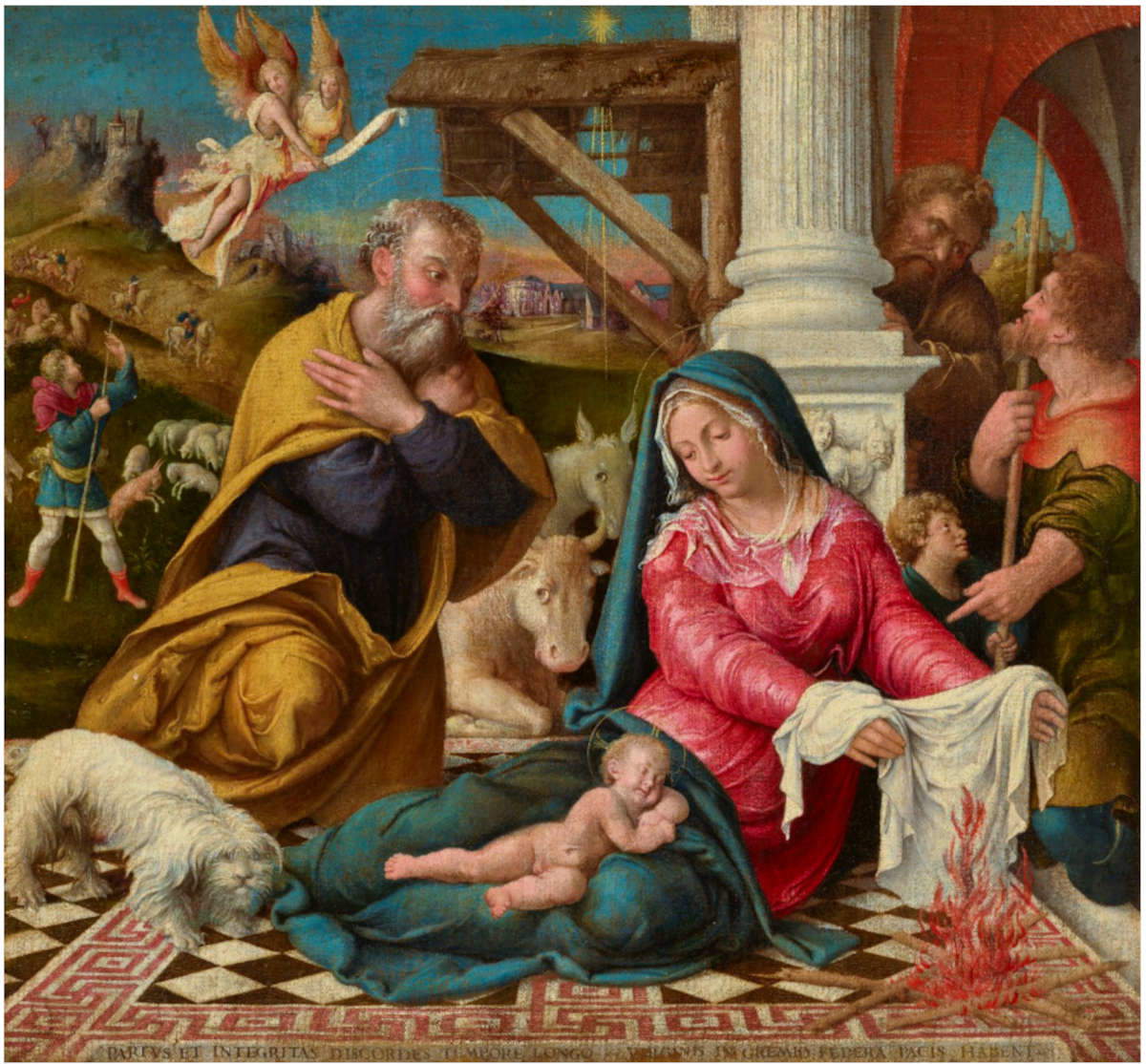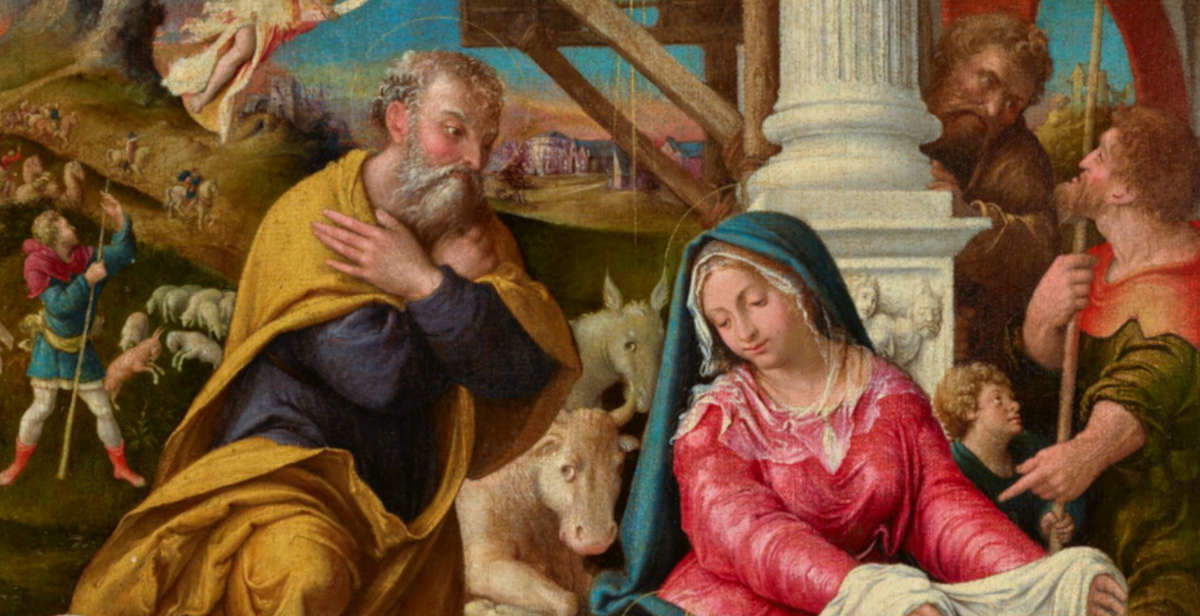Mantua, masterpiece by Girolamo Bonsignori joins Ducal Palace collection
In Mantua, the Ducal Palace recently enriched its collection of Renaissance art with an extraordinary work by Girolamo Bonsignori, theAdoration of the Shepherds. The painting was purchased at a Christie’s auction in New York on May 23, 2024 (awarded for the sum of $44,100, or just over 40,000 euros), and represents one of the institution’s most important acquisitions in recent years. The news of the acquisition was only given in the last few days on the occasion of the presentation of the work, which has been available to the public since last October 25, in the new display of the Renaissance collections of the Ducal Palace.
Considered by scholars to be one of the pinnacles of Bonsignori’s production, this painting offers a unique testimony to the work of the painter, of whom very few works remain. The authorship of this painting, datable to 1526-1529, has long been a matter of debate. Initially attributed to Lorenzo Lotto, it was only later traced back to Bonsignori, beginning with a critical reappraisal in recent decades. This change made the work even more valuable, and its current attribution is now well established. In 1998, scholar Gianni Romano even regarded theAdoration of the Shepherds as Bonsignori’s masterpiece. In 2010, Renato Berzaghi wrote instead that the work offers a summa of the artist’s poetics.
The acquisition of theAdoration of the Shepherds has aroused great interest because of the rarity and compositional complexity that characterize the work. Indeed, Bonsignori is known for an extremely limited body of work, but one of considerable historical and artistic significance. Born about 1472, according to a 1492 Verona register, Bonsignori was probably still called Matteo before taking vows in the Dominican order, where he later became “fra Girolamo.” In all likelihood, he died in 1529, and during his lifetime made only a few paintings, including this important masterpiece.
“The work,” says Stefano L’Occaso, director of the Ducal Palace, enthusiastically, “is truly a small masterpiece! The painting sums up the poetics of Girolamo Bonsignori, with forms and details that tie in with the decoration of the refectory of San Benedetto in Polirone and that assure us that both the canvas (now in Badia Polesine) and the frescoes, referred to Correggio at the time of their discovery, belong to Girolamo. Participating in an international auction was a complex operation, endorsed by the supervisory bodies and supported once again by the General Directorate for Museums, to which my sincere thanks go. It is a work that has allowed the heritage of the Ducal Palace to increase in a few years, in an extraordinary way.”

The profile of Girolamo Bonsignori: painter and Dominican friar
Fra’ Girolamo Bonsignori, born around 1472, was the brother of the better known Francesco Bonsignori, also a talented painter. Young Girolamo, probably known by his baptismal name Matteo until the age of 20, later entered the Dominican order. A testimony to his monastic and artistic life is offered by Giorgio Vasari, who in his work Le vite de’ più eccellenti pittori, scultori, e architettori speaks of Bonsignori as a man “not only of a holy and good life, but also a reasonable painter, as can be seen in the convent of San Domenico in Mantoa, where, besides other things, he made in the refectory a beautiful Last Supper and the Passion of the Lord, which by his death remained imperfect. He painted the same that beautiful Last Supper which is in the refectory of the monks of St. Benedict, in the very rich abbey which they have in the Mantoan.”
In another passage of the Lives, Vasari mentions two important works made by the friar in San Benedetto Po: “in the same place is by the hand of a friar Girolamo, converso of S. Domenico, in the refetory at the head, as elsewhere s’è ragionato, in an oil painting portrayed the beautiful cenacle that made in Milan in Santa Maria delle Grazie Lionardo da Vinci, portrait I say so well, that I was amazed.” In San Benedetto Po therefore, Bonsignori made a well-known depiction of the Last Supper inspired by Leonardo da Vinci’s more famous one in Santa Maria delle Grazie in Milan (the work is now in Badia Polesine: it returned to San Benedetto Po temporarily in 2019 on the occasion of an exhibition on the 16th century in Polirone). According to Vasari, Bonsignori’s interpretation of this scene was so detailed and well executed that it was awe-inspiring.
The remaining works: a reduced but significant corpus
Although the number of works attributable to Girolamo Bonsignori is limited, their quality testifies to the artist’s talent. Among the most famous are the aforementioned Last Supper, now preserved in Badia Polesine and originally located in the refectory of San Benedetto in Polirone, where the frescoes framing the Last Supper, usually given instead to Correggio, have also been attributed to Bonsignori.
Another important work is theAllegory of Faith, kept in the abbey church of the same complex. In Verona, in the Museo di Castelvecchio, are two organ doors with a scene of the Annunciation, from the church of San Pietro Martire in Murano and also attributed to Bonsignori. Finally, a small Christ Carrying the Cross on panel, signed by the artist, is in the Olomouc Museum at Šternberk Castle in the Czech Republic.
Due to thescarcity of works, it is difficult to trace Bonsignori’s complete stylistic evolution. However, the painting acquired by the Ducal Palace provides a fundamental record of his artistic development.
Iconographic details and influences: the uniqueness of theAdoration ofthe Shepherds
TheAdoration of the Shepherds is a complex scene rich in detail, highlighting the artist’s ability to blend symbolic and narrative elements. The painting presents an articulated composition, enriched by particular and unprecedented iconographic details. For example, the marble floor is decorated with a meandering pattern and a black and white checkerboard, similar to that used by Bonsignori in theLast Supper at San Benedetto Po. A bas-relief depicting David with the head of Goliath appears on the pillar of a column, recalling other Old Testament figures frescoed by the same author.
One of the most interesting elements is the image of the Virgin drying clothes by the fire, an unusual scene that is more common in depictions of the Nativity of the Virgin. This detail perhaps reflects a sensitivity of the artist to the everyday and familiar world, which is intertwined with the sacred message of the work.
The background of the painting also reveals a certain uniqueness, with a landscape reminiscent of the atmosphere of Nordic landscapes, featuring a towering cliff on the left and a distant city in the center. The colors of the sky, in reddish tones, further enrich the atmosphere of the painting, giving the scene a fantastic, almost visionary dimension.
Another significant detail of the painting is an inscription that appears at the bottom, in the center of the scene. The text, according to Gianni Romano’s studies, echoes a couplet by Jacopo Sannazaro from the poem De partu Virginis, completed in 1513 and published in 1526. The inscription, “Partus integritas, discordes tempore longo / virginis in gremio fœdera pacis habent,” reflects themes of purity and peace and is already attested at least as early as the 13th century. However, the verses’ popularity may have been influenced by Sannazaro himself, who was close to the Gonzaga court. The same couplet also appears in another Adoration of the Magi by Girolamo da Salerno, which can be dated around 1520 and is now in the Pio Monte della Misericordia in Naples.
A valuable contribution to the Renaissance collection of the Ducal Palace
With the addition of this painting to its collection, the Ducal Palace is enriched with an important testimony to Italian Renaissance painting. Girolamo Bonsignori’s work, with its stylistic refinement and iconographic complexity, represents a valuable contribution to the city’s artistic heritage. The decision to invest in such a rare and significant work confirms the museum’s commitment to the preservation and enhancement of Renaissance art.
For the public and scholars, this acquisition offers a unique opportunity to take a close look at the work of a little-known but highly significant artist whose works represent an important chapter in the history of Italian art. Palazzo Ducale thus confirms itself as a dynamic institution attentive to the enhancement of its artistic heritage, always ready to seize opportunities for cultural enrichment.
 |
| Mantua, masterpiece by Girolamo Bonsignori joins Ducal Palace collection |
Warning: the translation into English of the original Italian article was created using automatic tools. We undertake to review all articles, but we do not guarantee the total absence of inaccuracies in the translation due to the program. You can find the original by clicking on the ITA button. If you find any mistake,please contact us.





























